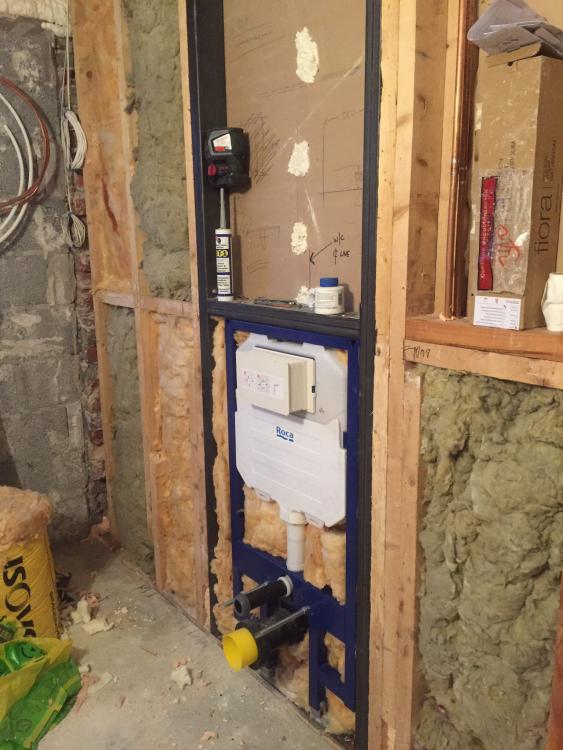Leaderboard
Popular Content
Showing content with the highest reputation on 09/11/23 in all areas
-
Yes absolutely as 100mm is barely BRegs these days !!! More the merrier ..!!3 points
-
I'd second that. If the chimney was complete then the upper parts could suffer condensation as the weather patterns changed. Venting the flue would help to remove moisture laden air. If it is now entirely within the heated part of the house and you are only looking to stop the warm air leaking into the roof void above the insulation then cover the redundant flue with insulation (preferably with a ply panel to stop someone accidently stepping through it!).2 points
-
I think this thread has got off topic. The original question from @flanagajwas how much would they expect to pay an architect. Please can we keep to this topic, not bashing architects. We all have a choice when paying anyone whether it be architects, lawyers, electricians or plumbers. We can decide if we are happy with their charges and pay them or go elsewhere. I think considering the interest in the forum from architects it is unfair for them to be so harshly singled out and bashed.2 points
-
That's probably what I meant. The night storage point is good...if you can store cheaper energy off-peak.2 points
-
Heat usage will be broadly the same, the decrement / response will be your issue although 150mm of concrete will have 20% more heat capacity than 125mm, so you could run it as a big storage heater overnight if calculated correctly. This is what @TerryE does with his setup.2 points
-
Architect fees can be a bit steep sometimes but I can see there is a fair amount of overhead, especially for ongoing training, bidding, schmoozing, premises, advertising etc. Lots of non-billable time there. I don't know many rich architects, but lots of comfortably rich vets, dentists, lawyers, surveyors etc.2 points
-
Who you going to call Mold Busters https://www.bustmold.com/resources/about-mold/where-to-look-for-mold/mold-on-insulation/2 points
-
I’d say “don’t” for all the reasons @Thorfun highlighted plus I guess you’d be cutting something down to do it and it would take an age for minimal gain.2 points
-
150mm insulation and 100mm concrete with a layer of A193 mesh to prevent cracking. Tie the UFH pipes to the mesh, set 50mm below the top. Does 100mm floor insulation even pass the BC requirements?2 points
-
The AC chaps are used to size the units based on the cooling load need to the measurement of the space, regardless of the level of insulation. Hopefully you can find a company that understands your main concern is heating, and they do a proper heat loss calculation(you can learn to do it yourself) so they can size according to that together with specification of the unit for heating(not cooling). Wall vs floor, in a single room It wouldn't make much difference(except if there's no space for the floor unit to be blocked by a table or couch). When you are trying to heat a larger area that is divided by walls with 2 units like in your case, I would opt for the wall units as they are able to direct/throw the flow of air a bit further into the room, but keep in mind ideally you would have another way to help the heated air migrate(a fan/duct to push or bring air in between the spaces). As the air around the unit heat up, it reduces the output/efficiency and stops whilst the air in the middle is at lower temp. In a water system, the heat is pumped around, with a split air system, you hope for the heat to evenly warm everything around(so plan to act on that) Ideally a central unit with ducts in the attic toward the extremities. watch this random example1 point
-
Depends entirely where in the country you are, but for many Virgin Media is the other choice Note 2 quotes over £2k does not exempt you from part R gigabit ready infrastructure (aka ducting) requirements, only from pre-installing the gigabit internet through said infrastructure.1 point
-
My apologies for teaching you how to suck eggs. your question therefore is only about what will heat the room best. it won't make a huge mount of difference i don't think. But for your immaculate floor surface the pipes would best be tied to the mesh in mid slab, where concrete gets all around it. also no risk of the chairs sitting on pipes.1 point
-
It's ok but 125 is better. the sawcut is the tidiest as it is exactly where you want it. Inducers are plastic things placed below that spot to make the slab weaker at that precise spot, but the cut should be enough . It would have to go full width though including the doorway, and all the way to the walls. i don't know if that works for your intended slab.1 point
-
Cracks do go right through. It can't be avoided. That isn't a problem structurally as there is aggregate interlock. (If they don't go right through then there really are problems with curling slabs, so let's not go there) ut it is the visible part of cracks on the surface that matter aesthetically, so seal them to prevent spillages or mop water seeping in, and you are probably going to be happy. However with careful preparation at the perimeter, crack inducers under partition walls and quality control of the concrete, the cracks will be minimal. The use of steel mesh, or fibres, will make the concrete crack infinitesimally all over and avoid any bigger cracks. But most importantly, keep the concrete as it comes. Give instructions to workers and the delivery driver that no water must be added. Surplus water evaporates and leaves the equivalent space within your slab. It does other stuff too, so never add water. But then, after the concrete is just hard, cover it and/or or spray it to keep it wet for at least a week. With your expectations I think do this for as long as possible, 2, 3 4 weeks.1 point
-
No. Energy in equals energy out. Assuming there is plenty of insulation, the energy will all end up as heat in the room. It will just be a bit slow to affect the room after turning up or down.1 point
-
There may be room behind the dabs to push the cables through. Could be simple, could be a pain. Try one and see!1 point
-
I don't think you are agreeing other than with yourself. Let's be constructive here.1 point
-
1 point
-
1 point
-
That looks like a concrete plinth, which is standard and fine. I'm worried tgat your staddle idea will act like a rocker. Pinned foundations are a standard thing too, allowing the column to rotate. As calculations don't appear to be likely, you should use prprietory fxings, as you seem to be, and overdo rather than underdo. When drilling and gluing rods, remember thst the first 25mm is considered as having no grip.1 point
-
Thanks for the reply. My take was that a single surveyor could do it as well. So that's great news! I was surprised when the guy I spoke to told me he couldn't do it. I'm sure our neighbour will be fine with that. Now still struggling to find someone to actually return calls/emails 🙄😂1 point
-
There is no need to each have your own surveyors. You can both agree to use the same surveyor who can draw up the PWA. If you go down the route of each having One, you have to pay for both of them. When they don't agree with each other, you will have to pay for a third to make a ruling. It will drag on forever, and cost you a fair amount of money. Try and get your neighbour to agree to use a single surveyor.1 point
-
But the spirit of the piece is positive isn't it ... the emphasis is on sharing and helping others to do the same . Just what BuildHub is doing in a slightly different way. Here's the map that the organisation publish (Open House Festival)1 point
-
If it finished at loft floor cap it off with a big slab of insulation and a weight to hold it down1 point
-
Puraflow can be a stand alone unit, what I meant was, why not have a PTP then a puraflow, as opposed to a septic tank first.1 point
-
Manufacturers offering psi-values will obviously promote their own products. The 2D thermal modeling of the junctions is time consuming and complex - I undertake them for the insulation company I work for as part of our technical and sales package. The problem with some current psi-values is to be acceptable under the current Building Regs and SAP 10 they must be done to the 2nd edition of BR497. Many older values were to the 1st edition and these can only be used for the previous Regs and SAP 2012. Note photo evidence is now required for many aspects of the build so the Regs have tried to close this loophole. I cannot say how successful this is or will be as I'm no longer an accredited SAP assessor. I baled out as I would be spending too much time chasing for these photos and other evidence and then being cast as the bad guy when they're not available (which is a BR failure!) or show a different insulation/thickness, etc, etc and the 'as built' potentially fails.1 point
-
SWMBO wants a part tiled WC. And she gets what she wants. The clue is in the title SWMBO.1 point
-
This came up on facebook! PLANNING OR BUILDING REGS PACKAGE £126.32 Existing & Propose Floor Plans, Elevations, Section, Block Plan & Site Location Plan.1 point
-
At such a cost it should be clean, and they should have documentation to prove it ca be disposed of with rainwater.1 point
-
I think the idea is that you have a gravel hardstanding and sit the Puraflo on that. But you'd really have to start talking to SEPA.1 point
-
im using greenbuildingstore to design and supply, we are fitting and commissioning ourself.1 point
-
Yes I concur with an asbestos survey first off but think like others this is white mild from a damp atmosphere, a few years ago I worked on a bungalow that had similar, not as bad, but complete lack of ventilation and a leaky roof. I stripped the roof, created eaves vents, ridge vents and fitted breathable felt and re tiled, no further problem.1 point
-
The second photo appears to show damp and either mould or crystals forming stalactites from the sarking boards. The pipe looks green. Is there any ventilation? Edit. Have found this about white mould.https://kpmrestoration.com/is-white-mold-dangerous/1 point
-
send it off for asbestos testing just to be on safe side, its a cheap service.1 point
-
From the arrangement of the residue it appears to have been airborne.. Is there a bathroom extractor not connected to outside? I've seen one installed in a bathroom with a flexi vent that just dumped into the void above and that created all kinds of pretty mold, stalagmites and stalagtites.1 point
-
There was a similar(ish) photo on a roofing FB group recently, and multiple people suggested salts. Which fits if you know there's water problems, but as you say if you "don't know" so it needs confirming properly.1 point
-
>>> I think we'll be going full-monty and 3-phasing the CU just for kicks. 😬 I think for general house stuff, single phase is good. Remember, we're trying to use less energy, and all our appliances are slowly getting more efficient. Sure 3P for potential car chargers, heat pumps etc. It slightly bothers me that there's potentially (see what I did there!) 400V between any two line conductors in the house, and I do have 3P in a domestic situation.1 point
-
I was in the same situation and went with 3 phase it was about £100 extra for the bigger 3P cable, which made sense to me at the time. If you are getting PV Panels the next question will be 3 phase or 1 phase inverter?1 point
-
Tesla (our curent EV) used to support 22kW (32A) but have downsized to 11kW (16A). I think its the extra weight and cost of the in-car charger that is difficult to justify. Saying that, we are going to install two 3P 32A chargers to cover all bases.1 point
-
Does anyone install them now, we are getting E7 it will be through a programmed smart meter, even though our smart meter, will be dumb, as we cannot connect to the radio link due to very poor signal.1 point
-
It's an area of development over the next few years, 22kW will become a standard offering. I'd also wait as long as possible before installing the 3P charger to benefit from the new Tech coming in, but easier to put the infrastructure in at the start.1 point
-
I'm surprised you got fed up with slow EV charging. You must do hundreds of miles or have short range. I've been cgarging overnight on a 3-pin plug at 2kW for the last 3 years and never had a problem. But then I rarely do > 150 miles in a day. Even so, we're getting 3-phase into our new build for 11kW EV charging. And we will be getting am E7 3P meter. (Smart meters are not a thing in Northern Ireland yet) With our DNO 3 x 100 amp phases is easy to get. Above 100 amp then the DNO insists on CT metering and that costs loads more, so 100A is the sweet spot here. Don't forget that few cars support 11kW and even fewer can charge at 22kW. A freind of mine just spent thousands upgrading to a 3-P supply only to discover his brand new EV (nissan ariya) doesn't do 3-p charging. So he wasted his money. If you can get 3P for the same price as 1P then go for it. I know a lot on here suggest splitting a single hase off into the house. I think we'll be going full-monty and 3-phasing the CU just for kicks. 😬1 point
-
Personally I'd keep with a (3ph) smart meter, as it enables many more variable rate tariffs than an old school economy 7 meter, and having a large contactor yank out power from appliances outside the cheap rate is very brutal. If you want to control when your EV charges or ASHP runs it's better for the device and probably more user friendly to use the built in control panel on it to set a schedule or whatever. 3ph Smart meters are also required by design to do "net metering" across phases, which is important if you're having PV at all. Old school meters it's pot luck how the installer configures it (at least, that's what I was told by one supplier)1 point
-
I wouldn’t go too thick with the slab. Anything thicker than about 100mm or 120mm will have a very poor response time. It will take you 3hr or between switching the UFH on and feeling the warmth. Although if It’sa heat pump system, maybe your plan is to run it almost all day at a low temp.1 point
-
they have to be double the size of normal rads because the water is cooler than gas ch. they get in the way of furniture etc , and send heat up the the ceiling. ufh warms the feet and gives a good feeling of warmth for lower air temperatures. what is the plan for floor finish?1 point
-
The ufh pipes are creating multiple thin points which may increase cracking...but having multiple tiny cracks is not a bad thing When you say polished, I hope you're not expecting a beautiful self- finish. Cracks are normal, but can be controlled 125 slab on 125 pir for me.1 point
-
I normally say to a potential client at first contact that they can be in the building in a year. That sometimes includes planning if they allow full design to commence. The reaction was 50/50 seems a long time / that's good. What to add to that? Time lost through client changes or stipulations. Can it be done quicker? A little quicker for a large extra cost, because you are giving us risk. Realistically say minimum 18 months construction period unless you are a very experienced construction manager or accept a standard kit building on a perfect site. @Harmony we are all sounding negative, but in your interest. We now need your response to confirm you are listening.1 point
-
To add. You’re doing the right thing in thinking about all of this now. We went too quickly I think and based our very early decisions on the look we wanted. It was only when I learnt more about it all (fabric first) from here and some books that I realised we should have spent more time researching building methods etc. I was being driven by the impending war in Ukraine and the impact it might have on the economy driving costs up even higher than post lockdown/COVID driven inflation. My plan was to start digging in the ground the day after we completed on the land 😂 How naive was I! Wiser now and sustained my first build injury yesterday when I slipped down my trailer and cracked two ribs.1 point
-
1 point
-
I thought I would cap off this thread to say we replaced the floor with 25mm ply and it is now entirely silent.1 point
















